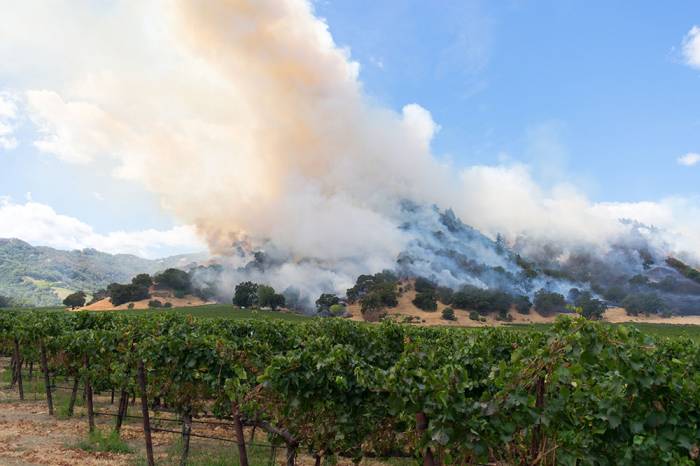Wildfire Smoke Threatens West Coast Vineyards as Industry Leaders Seek Solutions
Researchers, growers, and insurers collaborate on detection, prevention, and insurance strategies to protect wine production from smoke damage.
2025-10-08

The annual Smoke Summit, organized by the West Coast Smoke Exposure Task Force (WCSETF), brought together more than 350 participants from 19 states and nine countries on July 15 to discuss the ongoing challenges that wildfire smoke poses to the wine industry. The event featured presentations from researchers, industry leaders, and insurance experts, with a focus on the latest findings, research initiatives, and practical solutions for growers and winemakers in California, Oregon, and Washington.
Natalie Collins, president of the California Association of Winegrape Growers and co-chair of WCSETF, opened the summit by highlighting the lasting impact of wildfire smoke on vineyards and wine production. She emphasized the importance of collaboration and scientific progress in addressing these challenges. The summit has become a key forum for sharing knowledge and developing strategies to mitigate smoke exposure risks.
Dr. Tim Rinehart, a national program leader with the USDA Agricultural Research Service (ARS), discussed federal funding for smoke exposure research. Since 2020, about $5 million of the USDA’s $27 million annual grape research budget has been dedicated to studying smoke exposure in winegrapes. Rinehart noted that more than 25 scientists are involved in this collaborative effort. He also mentioned that new funding could be available in the fiscal 2026 appropriations bill, which would allow researchers to expand their work. A new research roadmap, developed after a November 2024 industry workshop by Dr. Arran Rumbaugh, will guide future projects and help identify gaps in current knowledge.
Dr. Rumbaugh, a USDA-ARS research chemist, outlined her program’s four main areas: early portable detection of smoke compounds, establishing thresholds for damage, atmospheric analysis, and metabolic studies. She stressed the importance of collecting data to improve predictive models and guide decision-making for growers. Other USDA-ARS researchers are working on biotechnology tools to understand grapevine responses to smoke, spray coatings to prevent smoke taint, atmospheric modeling for risk assessment, and rapid assessment methods for smoke taint in grapes and wine.
Dr. Torey Arvik, a food technologist with USDA-ARS, presented his work on practical ways to reduce smoke impact during winemaking. His research evaluates commercial tools and treatment rates to determine their effectiveness in improving wine quality and economic value after smoke exposure.
Oregon State University’s Dr. Elizabeth Tomasino shared her research on interpreting grape and small fermentation data to help winemakers decide how to handle potentially affected fruit. She recommended chemical testing as the most reliable method for detecting smoke taint and advised growers to conduct small-scale fermentations before harvest. Tomasino also encouraged careful record-keeping and understanding baseline thresholds for each vineyard or wine style.
Dr. Tom Collins from Washington State University presented findings on how proximity to wildfires affects the risk and severity of smoke damage. He explained that vineyards closer to fires are at greater risk because smoke compounds degrade as they travel through the atmosphere. Even within a single vineyard, the level of impact can vary depending on distance from the fire.
Insurance options were also discussed at the summit. Kristine Fox from Relation Insurance explained the benefits of multi-peril crop insurance (MPCI) and fire insurance for growers facing smoke exposure. She stressed the importance of documentation, including vineyard samples, marketing records, lab tests, and even storing grape clusters in freezers as evidence for insurance claims. A new Fire Insurance Protection Smoke Index (FIP-SI) Endorsement was introduced in California in 2025, providing county-level coverage specifically for smoke events. This endorsement is expected to expand to Oregon, Washington, and Idaho after proving successful in its first year.
The WCSETF continues to serve as a central resource for winegrape growers and vintners dealing with wildfire smoke. Its website offers best practices, research updates, insurance information, and recordings of past summits. The coalition remains committed to supporting the industry with timely information and practical tools as wildfires remain a persistent threat to vineyards across the West Coast.
Founded in 2007, Vinetur® is a registered trademark of VGSC S.L. with a long history in the wine industry.
VGSC, S.L. with VAT number B70255591 is a spanish company legally registered in the Commercial Register of the city of Santiago de Compostela, with registration number: Bulletin 181, Reference 356049 in Volume 13, Page 107, Section 6, Sheet 45028, Entry 2.
Email: [email protected]
Headquarters and offices located in Vilagarcia de Arousa, Spain.